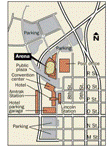Community and Regional Planning Program
ORCID IDs
Abigail L. Cochran https://orcid.org/0000-0002-7866-4865
Noreen C. McDonald https://orcid.org/0000-0002-4854-7035
Lauren Prunkl https://orcid.org/0000-0001-8136-4874
Emma Vinella‑Brusher https://orcid.org/0000-0001-6416-6892
Jueyu Wang https://orcid.org/0000-0003-1568-0195
Lindsay Oluyede https://orcid.org/0000-0002-1039-8409
Mary Wolfe https://orcid.org/0000-0001-6043-1433
Date of this Version
2022
Citation
Cochran et al. BMC Public Health (2022) 22:1783
https://doi.org/10.1186/s12889-022-14149-x
Abstract
Background: Transportation problems are known barriers to health care and can result in late arrivals and delayed or missed care. Groups already prone to greater social and economic disadvantage, including low-income individuals and people with chronic conditions, encounter more transportation barriers and experience greater negative health care consequences. Addressing transportation barriers is important not only for mitigating adverse health care outcomes among patients, but also for avoiding additional costs to the health care system. In this study, we investigate transportation barriers to accessing health care services during the COVID-19 pandemic among high-frequency health care users.
Methods: A web-based survey was administered to North Carolina residents aged 18 and older in the UNC Health system who were enrolled in Medicaid or Medicare and had at least six outpatient medical appointments in the past year. 323 complete responses were analyzed to investigate the prevalence of reporting transportation barriers that resulted in having arrived late to, delayed, or missed care, as well as relationships between demographic and other independent variables and transportation barriers. Qualitative analyses were performed on text response data to explain transportation barriers.
Results: Approximately 1 in 3 respondents experienced transportation barriers to health care between June 2020 and June 2021. Multivariate logistic regressions indicate individuals aged 18–64, people with disabilities, and people without a household vehicle were significantly more likely to encounter transportation barriers. Costs of traveling for medical appointments and a lack of driver or car availability emerged as major transportation barriers; however, respondents explained that barriers were often complex, involving circumstantial problems related to one’s ability to access and pay for transportation as well as to personal health.
Conclusions: To address transportation barriers, we recommend more coordination between transportation and health professionals and the implementation of programs that expand access to and improve patient awareness of health care mobility services. We also recommend transportation and health entities direct resources to address transportation barriers equitably, as barriers disproportionately burden younger adults under age 65 enrolled in public insurance programs.


Comments
Open Access